For Individuals with Autism
Sometimes individuals with autism want or need to learn more about their autism. These books can help guide conversations with a child/teen about sensory issues, special interests, flexible thinking, and other matters. (If you are not a family member, be sure to include the parent/guardian/caregiver in the decision to have discussions about a child’s autism before reading these books with a child.)

“A” Is for All Aboard
Author: Paula Kluth
Grade Levels: Preschool-2nd grade (and anyone interested in trains)
Short Summary:
The first alphabet book created with children with autism in mind, A Is for "All Aboard!" is the perfect way to foster literacy using children's fascinations. An ideal complement to Kluth & Chandler-Olcott's "A Land We Can Share": Teaching Literacy to Students with Autism, this one-of-a-kind book is
- All about trains—one of the most popular interests of children with autism
- Filled with vibrant, engaging, and uncluttered art
- Written for children of all reading levels, with vocabulary ranging from basic concepts (bridge) to special train jargon (idler car, monorail)
- Shaped by feedback from children with autism
- Complete with helpful teaching tips for educators and parents
Sure to captivate children with autism—and any young train enthusiast—this book will help kids of all ages improve their literacy skills as they learn the ABCs of one of their favorite topics.
Themes/Topics Covered:
- Trains
- Alphabet

A Week of Switching, Shifting, and Stretching: How to Make My Thinking More Flexible
Author: Lauren H. Kerstein
Grade Levels: 1-4 grade
Short Summary:
Empower children on the spectrum to be more flexible! This picture book assists children on the autism spectrum, and any child for that matter, to improve their executive function skills. Specifically, A Week of Switching, Shifting, and Stretching How to Make My Thinking More Flexible guides children to examine their black-and-white thinking in order to start using their adaptive thinking. Using repeated rhymes and illustrations, the child begins to recognize that the more flexible their thinking, the better they can cope with the challenges that life presents, ultimately leading to fewer meltdowns.
Themes/Topics Covered:
- Autism
- Executive function
- Flexible thinking
Supplemental Resources:

All My Stripes: A Story for Children with Autism
Author: Shaina Rudolph
Grade Levels: Preschool-2nd grade
Short Summary:
This is the story of Zane, a zebra with autism, who worries that his differences make him stand out from his peers. Zane rushes home to tell his mother about problems he faced during his school day, and she reminds him that while others may only see his "autism stripe," he has stripes for honesty, caring, and much more.
Themes/Topics Covered:
- Autism
- Differences as a positive
Supplemental Resources:
- YouTube Video with introduction by person with autism and then story read by puppet zebras
- Lesson Plan from University of Central Florida
- Video and discussion questions
- Teachers Pay Teachers has several resources for a fee:

Arnie and His School Tools: Simple Sensory Solutions That Build Success
Author: Jennifer Veenendall
Grade Levels: 1st to 3rd grade
Short Summary:
International Book Award Winner! Antecedent based interventions, an evidence-based practice, can help children with sensory challenges. International Book Award Winner Arnie and His School Tools: Simple Sensory Solutions to Build Success is an illustrated children's book about an exuberant little boy who had difficulty paying attention in class and doing his schoolwork until he is given the tools to accommodate his sensory needs. Written from Arnie's point of view, the book uses simple language to describe some of the sensory tools and strategies he uses at school and home to help him achieve a more optimal level of alertness and performance. Arnie and His School Tools create an environment that is accepting of students with sensory difficulties, including many on the autism spectrum. Occupational therapists, teachers and parents will find this book an engaging way to introduce elementary students to basic sensory tools used to help children focus in classroom settings, such as fidgets, chewy pencil toppers, and weighted vests. Additional resources are provided at the end of the book, including definitions of sensory processing and sensory modulation disorder, suggested discussion questions, and lists of related books and websites.
Themes/Topics Covered:
- Sensory challenges
- Sensory interventions
Supplemental Resources:
- Resources (related books and websites) are provided at the end of the book
- Arnie and His School Tools Shoebox Task Design/grades 3-6/Cost $2.50 as of Jan. 2022
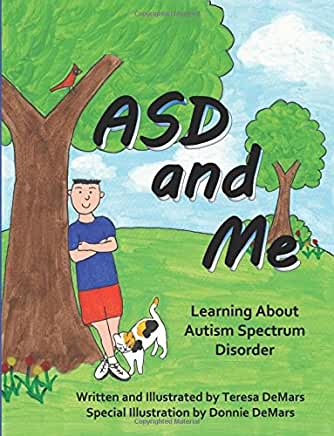
ASD and Me: Learning About Autism Spectrum Disorder
Author: Teresa DeMars (parent of a child with autism)
Grade Levels: Kindergarten-3rd grade
Short Summary:
Back in 2010, author Teresa DeMars went looking for a book to explain autism to her son. When she couldn’t find one that fit the characteristics of his autism, she wrote ASD and Me. Written for kids diagnosed with Asperger’s Syndrome, PDD-NOS, or autism, parents will appreciate the way this heartwarming children's picture book will help them explain Autism Spectrum Disorder (ASD) to their child on the spectrum. ASD and Me is written from the point of view of Eli, a seven-year-old boy who has ASD. Through the story, Eli explains how he was diagnosed, and how ASD affects the way he thinks and interprets the world around him. He also talks about some of the social and life skills he has learned that help him fit in with others. The story concludes with some of the interests and activities Eli shares with other children. ASD and Me is a great book to help introduce the subject of autism to siblings, classmates, extended family and to those on the spectrum. (Updated print version of the book may not be available from third party sellers.)
Themes/Topics Covered:
- Autism
- Sibling/family
Supplemental Resources:
- Activities based on Eli’s interests are provided in the book

ASD Zoo of Kalamazoo
Author: Josie Santomauro (parent of a child with autism)
Grade Levels: Preschool
Short Summary:
The ASD Zoo of Kalamazoo is an illustrated, rhyming children s book that connects the characteristics of various zoo animals to the major social skills characteristics of children with autism spectrum disorder. In the Kalamazoo Zoo there are a lot of animals that have ASD. The book demonstrates how these animals exhibit specific characteristics, eccentric behaviors and special needs. These animals with ASD handle their diagnosis, challenges and successes by learning to live in harmony with the other social and neuro-typical animals. The goal of this book is for children to recognize their own characteristics and learn how to capitalize on them or adapt for greater success in the social realm. This resource can be used with children and their peers to talk openly about diagnosis, challenges and differences when it comes to ASD. Professionals can also use the resource in schools or clinics.
Themes/Topics Covered:
- Understanding autism and how it impacts the child
- Socialization with peers
- Rhyming

Asperger’s Huh? A Child’s Perspective
Author: Rosina G. Schnurr, Author; John Strachan, Illustrator
Grade Levels: Kindergarten-4th grade
Short Summary:
An Excellent book for children who have Asperger's Disorder." Review comments of an adult with Asperger's Disorder. A wonderfully simple and insightful view into the world of a child with Asperger's Disorder. Parents and children, as well as teachers and other professionals, will benefit from the practical and positive approach of this book.
Themes/Topics Covered:
- Information from individuals with autism

Autismo... ¿qué es eso? (Spanish Edition)
Author: Ymkje Widerman-van der Laan and Rob Feldman
Grade Levels: 10- 12 years
Short Summary:
En este libro para niños autistas, Logan escucha a su abuela decirle a su amigo que tiene autismo y él le pregunta: "Autismo… ¿qué es eso?" Ella le explica qué es el autismo para él en esta historia bellamente ilustrada. Los niños con autismo enfrentan muchos desafíos y, a menudo, son conscientes de su autismo y lo cuestionan. Por supuesto, cada niño es único y es posible que desee o no explicar el término autismo a su hijo a una edad temprana. Pero si lo hace, este libro puede ayudarlo a que sea más fácil para usted, como lo hizo con el autor cuando le explicó el autismo a Logan. Su mente inquisitiva quería saber, y una vez que leyó esta historia, incluso antes de que fuera ilustrada, se sintió feliz con esta explicación positiva y la respuesta a su pregunta.
Themes/Topics Covered:
- familias
- autismo
- auto-aceptación
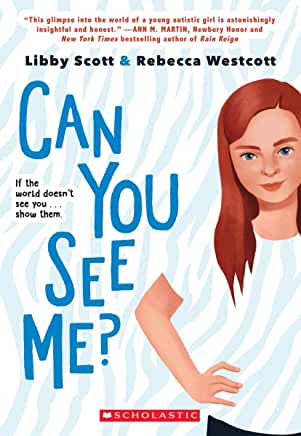
Can You See Me?
Author: Libby Scott (autistic) and Rebecca Westcott
Grade Levels: 3-6 grade
Short Summary:
Things Tally is dreading about sixth grade:
- Being in classes without her best friends
- New (scratchy) uniforms
- Hiding her autism
Tally isn't ashamed of being autistic -- even if it complicates life sometimes, it's part of who she is. But this is her first year at Kingswood Academy, and her best friend, Layla, is the only one who knows. And while a lot of other people are uncomfortable around Tally, Layla has never been one of them…until now.
Something is different about sixth grade, and Tally now feels like she has to act "normal." But as Tally hides her true self, she starts to wonder what "normal" means after all and whether fitting in is really what matters most.
Inspired by young coauthor Libby Scott's own experiences with autism, this is an honest and moving middle-school story of friends, family, and finding one's place.
Themes/Topics Covered:
- Autism
- Self-awareness
- Empathy
- Middle school
- Masking
Supplemental Resources:

Decibella
Author: Julia Cook
Grade Levels: 4-7 years
Short Summary:
She loves using her loud voice so much, everyone calls her "Decibella!" But that's not a nickname to brag about. Isabella's so loud, she interrupts class and irritates others. She doesn't know how or when to use a softer, quieter voice until her teacher introduces the "five volume" of voice - 6-inch, Whisper, Table-Talk, Strong Speaker, and Outside. Learning how and when to use each voice is made a lot more fun when Isabella is told to practice by saying aloud the word "Slurpadoodle!"
Award-winning author Julia Cook's creative storytelling, coupled with eye-pleasing illustrations, help K through 6 readers learn and remember what voice volume to use when speaking in class, chatting in the library, sitting at the lunch table, or playing outside.
Themes/Topics Covered:
- Autism
- Behavior Management
- Self-Control
- Friendship
Supplemental Resources:
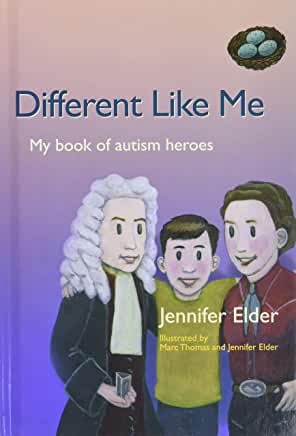
Different Like Me: My Book of Autism Heroes
Author: Jennifer Elder (mother of autistic son)
Grade Levels: Grades 3-7
Short Summary:
Different Like Me introduces children aged 8 to 12 years to famous, inspirational figures from the world of science, art, math, literature, philosophy and comedy.
Eight-year-old Quinn, a young boy with Asperger's Syndrome, tells young readers about the achievements and characteristics of his autism heroes, from Albert Einstein, Dian Fossey and Wassily Kandinsky to Lewis Carroll, Benjamin Banneker and Julia Bowman Robinson, among others. All excel in different fields but are united by the fact that they often found it difficult to fit in-just like Quinn.
Fully illustrated in color and written in child-friendly language, this book will be a wonderful resource for children, particularly children with autism, their parents, teachers, carers and siblings.
Themes/Topics Covered:
- Diversity
- Intelligence
- Peers
- Friendship

I am an Aspie Girl: A Book for Young Girls with Autism Spectrum Conditions
Author: Danuta Bulhak-Paterson (Author), Teresa Ferguson (Illustrator)
Grade Levels: 3rd-5th grades
Short Summary:
Lizzie is an Aspie Girl - she has Asperger's Syndrome, which means that her brain works differently to her friends, and even to boys with Asperger Syndrome. In this book, Lizzie explains what it's like to be an Aspie Girl, including how she has a special talent for blending in with her friends, how she gets really tired after being at school all day, how she worries about making mistakes, and how she finds it hard to understand how she is feeling.
By simply, clearly and positively explaining the social differences associated with Asperger's Syndrome, or Autism Spectrum Disorder, in young girls, this book will help Aspie Girls aged 5-11 to understand their diagnosis, recognize their unique strengths and celebrate their differences, and find ways of coping with difficulties. This positive and celebratory book also contains helpful discussion points for parents and professionals to explore further with the girls in their care.
Themes/Topics Covered:
- Autism and girls
- Social differences
- Masking
- Feelings
Supplemental Resources:
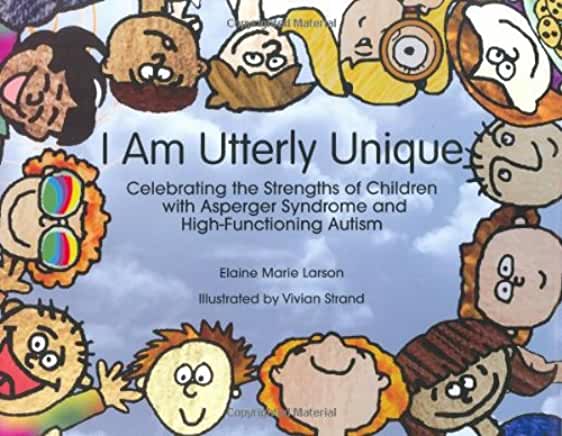
I Am Utterly Unique: Celebrating the Strengths of Children with Asperger Syndrome and High-Functioning Autism
Author: Elaine Marie Larson
Grade Levels: Preschool through 3rd grade
Short Summary:
Discover the unique characteristics and abilities of children with Asperger Syndrome and high-functioning autism from A to Z. This book, laid out in an A-to-Z format, celebrates the extraordinary gifts and unique perspectives that children with ASD possess. Each page of this playful alphabet book presents one of the children s many talents and abilities. The kid-friendly illustrations and clever text create a positive portrayal of children with ASD.
Themes/Topics Covered:
- Autism
- Special interests
Supplemental Resources:

Learning about Friendship: Stories to Support Social Skills Training in Children with Asperger Syndrome and High Functioning Autism
Author: Kay Al-Ghani
Grade Levels: Preschool-2nd grade
Short Summary:
Making friends can be a challenge for all children, but those with autistic spectrum disorder (ASD) can struggle more than most. This collection of ten fully illustrated stories explores friendship issues encountered by children with ASD aged four to eight and looks at how they can be overcome successfully.
Key problem areas are addressed, including sharing, taking turns, being a tattletale, obsessions, winning and losing, jealousy, personal space, tact and diplomacy, and defining friendship. The lively and entertaining stories depersonalize issues, allowing children to see situations from the perspective of others and enabling them to recognize themselves in the characters. This opens the door to discussion, which in turn leads to useful insight and strategies they can practice and implement in the future. Each story has a separate introduction for adults which explains the main strategies within it.
This book will be a valuable resource for all parents and teachers of children with ASD, along with their friends and families, and anybody else looking to help children on the spectrum to understand, make and maintain friendships.
Themes/Topics Covered:
- Sharing
- Taking turns
- Being a tattletale
- Obsessions
- Winning and losing
- Jealousy
- Personal space
- Friendship
Supplemental Resources:
- Helping Kids with Autism Make Friends
- Friendship Books Worksheets and Teaching Resources - some free and others at a cost from $2 to $24
- Free Social Stories about Friendships (plus a video)

My Best Friend Will
Author: Jamie Lowell and Tara Tuchel
Grade Levels: 2nd and 3rd grades
Short Summary:
This stunning black-and-white photo journal chronicles the relationship between 11-year-old neurotypical Jamie and her friend Willie who has autism. The reader enters Willie’s world through Jamie’s eyes to witness events that unfold at school, at home, and at play. In the process, you will gain a rich understanding and appreciation of Willie’s many unique qualities and come to accept that they are all a part of who he is.
Themes/Topics Covered:
- Autism
- Friendship
Supplemental Resources:

Oliver Onion: The Onion Who Learns to Accept and Be Himself
Author: Dianne Murrell
Grade Levels: Grade level 1-2
Short Summary:
Readers and listeners who have delighted in Diane Murrell's earlier picture book, Tobin Learns to Make Friends, will welcome her latest book written for and addressing some of the major issues faced by all children, but particularly so by those with autism spectrum disorders. Oliver the Onion doesn't like himself. But when he decides to try on the "look" of a tempting-looking orange, he soon realizes that he cannot run away from who he is but should instead celebrate his uniqueness. Oliver Onion is written for 4- to 10-year-olds but the colorful illustrations and heartfelt message will appeal to children and adults alike. A discussion guide helps teachers and others engage children in thoughtful exploration of the book.
his sensitive and heart-warming story emphasizes the importance of a strong sense of self and self-acceptance the very foundation upon which our children must develop. A great story to prepare our children for the challenges in today's diverse society.
Themes/Topics Covered:
- Acceptance
- Friendship
Supplemental Resources:
- Students could journal “What makes me unique?” Create poems or draw a picture. “I like me because....”

Squirmy Wormy: How I Learned to Help Myself
Author: Lynda Farrington Wilson
Grade Levels: Kindergarten-4 grade
Short Summary:
Many kids have some form of SPD (Sensory Processing Disorder), but who can help them overcome their daily struggles? Wait . . . they can help themselves!
Lynda Farrington Wilson, along with Tyler and some delightful illustrations, help kids help themselves through daily life like no one has before with some great everyday tips and techniques.
Squirmy Wormy is a wonderful little children's book about a boy named Tyler, who has autism and SPD. Together with Tyler, the reader learns about SPD and what easy therapies he can do by himself to feel better. For instance: "I feel like running really fast, run run run! Maybe I just need a s-q-u-e-e-z-e between the couch cushions like a hot dog. Whew! I feel better."
Endorsed by Dr. Temple Grandin, this book is sure to help many children (who perhaps previously did not even know they had SPD) lead calmer, richer lives.
Themes/Topics Covered:
- Sensory processing disorder
- Sensory interventions
Supplemental Resources:
- Could include fidgets while reading the book to help students learn about sensory challenges

The Kaleidoscope Kid
Author: Elaine Marie Larson
Grade Levels: Preschool-4 grade
Short Summary:
The Kaleidoscope Kid is written for children with Asperger Syndrome and high-functioning autism to remind them of their many special gifts. Children on the autism spectrum possess a kaleidoscope of intellectual strengths and unique personality traits. Their outlook and creative ways are as variable and colorful as the view through a kaleidoscope. Written in light verse and illustrated in bold, colorful and entertaining illustrations, The Kaleidoscope Kid draws the reader to the book with the colorful, bold design of its cover. The interesting illustrations inside provide a vivid backdrop for the poetry. The book touches on subjects familiar and dear to children including pets and friends and a few of kids favorite things like dinosaurs, holidays, and summer vacations. The reader is reminded that those with Aspergers syndrome and high-functioning autism can proudly acknowledge to themselves that they are excellent, special and one-of-a-kind individuals. They are usually truthful, helpful and dependable. The book is an expansion on Elaine Marie Larson s first book, I Am Utterly Unique, an ABC book on the positive traits exhibited by children on the autism spectrum for children ages 4-10. The Kaleidoscope Kid can be enjoyed by children in this younger group, but entertains and educates readers of all ages through light verse.
Themes/Topics Covered:
- Autism
- Special interests
- Pets
- Friends
- Holidays
- Summer vacations
Supplemental Resources:
- May want to start with the book I Am Utterly Unique
- Have students write poems about their own special interest

The Kids' Guide to Staying Awesome and In Control: Simple Stuff to Help Children Regulate their Emotions and Senses
Author: Lauren Brukner
Grade Levels: K-5
Short Summary:
Packed with simple ideas to regulate the emotions and senses, this book will help children tackle difficult feelings head-on and feel awesome and in control!
From breathing exercises, pressure holds and finger pulls, to fidgets, noise-reducing headphones and gum, the book is brimming with fun stuff to help kids feel cool, calm and collected. They will learn how to label difficult feelings, choose the perfect strategies and tools to tackle them, and use these correctly whether at home or at school. The strategies and tools are accompanied by cartoon-style illustrations, and the author includes useful tips for parents and teachers as well as handy visual charts and checklists to track learning and progress.
Armed with this book, kids will be well on their way to managing difficult emotions and feeling just right in whatever situation life throws at them!
Themes/Topics Covered:
- Autism
- Sensory
- Self-regulation
Supplemental Resources:

This is Me! I Am Who I’m Meant to Be!
Author: Amy Pfluger (mother of 2 boys with autism)
Grade Levels: K-4th grade
Short Summary:
Have you wondered what the world is like through the eyes of someone with Autism? Able is a boy who has autism, inviting you to visit his unique world. This book explains autism in a special way, to help people understand more about autism, to embrace differences and to raise acceptance. This story is to empower kids with autism to believe in themselves and reach their full potential no matter what challenges they have; encouraging them to be confident in being who they are- because they are who they're meant to be!
"This is me! I am who I'm meant to be!" will show you the uniqueness and power of autism, while taking you on a journey of self-acceptance
This autism children's book is a great tool. Parents face challenges raising children with autism, ADHD, oppositional defiant disorder, also challenges in raising an exceptional child. A family guide to helping the special needs, encouraging kids in being who you are, discover your child's abilities, build confidence for kids, embracing our difference and dealing with anxiety and depression. A great autistic book for kids!
Themes/Topics Covered:
- Autism acceptance
- Self-acceptance
- Resilience
- Challenges
- Differences
Supplemental Resources:
- Video Read Aloud
- Great to use during spirit week @ school (superpowers)
- Have students dress-up as their favorite superhero
- Design a cape using words that describe your unique self. Can use a towel or a sheet.
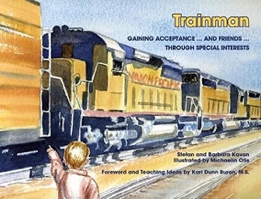
Trainman: Gaining Acceptance and Friends Through Special Interests
Author: Stefan Kavan
Grade Levels: 3-7 grade
Short Summary:
In this warmly illustrated children's book, we meet Stefan, who has a deep interest in trains, roads, and maps. At first, Stefan's near-exclusive interest in transportation-related topics isolated him from other kids, but his parents and teachers helped turn his unique talents into an asset. His classmates now respect Stefan for his vast knowledge and have come to recognize that he is more like them than different. This book is an ideal addition to any autism awareness program at the elementary level.
Themes/Topics Covered:
- Special interests
- Autism
- Acceptance

Voices are Not for Yelling
Author: Elizabeth Verdick
Grade Levels: 4-7 years
Short Summary:
As parents and teachers know, yelling comes naturally to children. This friendly, encouraging book, geared to preschool and primary children, introduces and reinforces where and when to use an “indoor voice” or an “outdoor voice.” In classic Best Behavior style the author tells young readers, “Your voice is a powerful tool. How you use it is up to you.” Vivid illustrations show the times and places for an indoor voice, the ways people ask us to quiet our voices, and times when yelling might occur. “What happens if you’re mad or frustrated or really, really excited? Your voice gets louder and LOUDER.” But yelling hurts people’s ears and feelings. Children learn that they can quiet their voice and use their words to talk about a problem. “Think before you yell, and use your words well!” Includes a special section for parents and caregivers with activities and discussion starters.
Themes/Topics Covered:
- Autism
- Friendship
- Acceptance
Supplemental Resources:

What Does Happy Look Like?
Author: Joseph Karim
Grade Levels: Preschool-2nd grade
Short Summary:
Emotions are difficult for most children to understand, they pose a particular challenge for children with autism spectrum disorders due to their literal and concrete way of thinking and learning. Help for children now comes in the form of this charming picture book, which presents examples of the basic emotions, happy, sad, mad, etc., in environments and situations that are familiar to children and, therefore, are easier to understand. Fun activities at the back of the book make this a truly interactive instructional experience.
Themes/Topics Covered:
- Autism
- Emotions